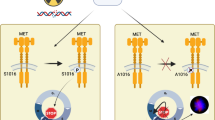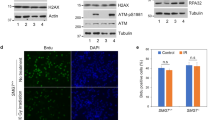Abstract
Octamer transcription factor-1 (Oct-1) has recently been shown to function as a stress sensor that promotes cell survival subsequent to DNA damage. Here, we show that the survival signal imparted by Oct-1 following exposure to ionizing radiation (IR) is dependent upon DNA-dependent protein kinase (DNA-PK)-dependent phosphorylation of a cluster of 13 specific ser/thr residues within the N-terminal transcriptional regulatory domain of Oct-1. Although IR treatment did not affect the recruitment of Oct-1 to the histone H2B promoter, the recruitment of RNA polymerase II, TATA-binding protein and histone H4 acetylation were strongly reduced, consistent with a decrease in Oct-1 transcriptional regulatory potential following IR exposure. Ser/Thr-Ala substitution of 13 sites present in Oct-1 transcriptional regulatory domain eliminated Oct-1 phosphorylation subsequent to IR exposure. Further, these substitutions prevented Oct-1 from rescuing the survival of IR-treated Oct-1/ murine embryonic fibroblasts, providing a direct link between DNA-PK-dependent phosphorylation and the contribution of Oct-1 to cell survival. These results implicate Oct-1 as a primary effector in a DNA-PK-dependent cell survival pathway that is activated by double-stranded DNA breaks.
This is a preview of subscription content, access via your institution
Access options
Subscribe to this journal
Receive 50 print issues and online access
$259.00 per year
only $5.18 per issue
Buy this article
- Purchase on Springer Link
- Instant access to full article PDF
Prices may be subject to local taxes which are calculated during checkout





Similar content being viewed by others
References
Bailey SM, Goodwin EH . (2004). DNA and telomeres: beginnings and endings. Cytogenet Genome Res 104: 109–115.
Bharti A, Kraeft SK, Gounder M, Pandey P, Jin S, Yuan ZM et al. (1998). Inactivation of DNA-dependent protein kinase by protein kinase Cdelta: implications for apoptosis. Mol Cell Biol 18: 6719–6728.
Chan DW, Chen BP, Prithivirajsingh S, Kurimasa A, Story MD, Qin J et al. (2002). Autophosphorylation of the DNA-dependent protein kinase catalytic subunit is required for rejoining of DNA double-strand breaks. Genes Dev 16: 2333–2338.
Chan DW, Ye R, Veillette CJ, Lees-Miller SP . (1999). DNA-dependent protein kinase phosphorylation sites in Ku 70/80 heterodimer. Biochemistry 38: 1819–1828.
Collis SJ, Deweese TL, Jeggo PA, Parker AR . (2005). The life and death of DNA-PK. Oncogene 24: 949–961.
de Jong RN, van der Vliet PC . (1999). Mechanism of DNA replication in eukaryotic cells: cellular host factors stimulating adenovirus DNA replication. Gene 236: 1–12.
Douglas P, Sapkota GP, Morrice N, Yu Y, Goodarzi AA, Merkle D et al. (2002). Identification of in vitro and in vivo phosphorylation sites in the catalytic subunit of the DNA-dependent protein kinase. Biochem J 368: 243–251.
Eble MJ, Hensley FW, Flentje M, Schlotz A, Wannenmacher M . (1994). A modified computer-assisted colorimetric microtitre assay (MTT) to assess in vitro radiosensitivity of V79, CaSki, HeLa and WiDr cells. Int J Radiat Biol 65: 193–201.
Ferguson DO, Alt FW . (2001). DNA double strand break repair and chromosomal translocation: lessons from animal models. Oncogene 20: 5572–5579.
Fletcher C, Heintz N, Roeder RG . (1987). Purification and characterization of OTF-1, a transcription factor regulating cell cycle expression of a human histone H2b gene. Cell 51: 773–781.
Giffin W, Kwast-Welfeld J, Rodda DJ, Prefontaine GG, Traykova-Andonova M, Zhang Y et al. (1997). Sequence-specific DNA binding and transcription factor phosphorylation by Ku Autoantigen/DNA-dependent protein kinase. Phosphorylation of Ser-527 of the rat glucocorticoid receptor. J Biol Chem 272: 5647–5658.
Gunawardena J . (2005). Multisite protein phosphorylation makes a good threshold but can be a poor switch. Proc Natl Acad Sci USA 102: 14617–14622 (E-pub 2005 Sept 29).
Heckman CA, Duan H, Garcia PB, Boxer LM . (2005). Oct transcription factors mediate t(14;18) lymphoma cell survival by directly regulating bcl-2 expression. Oncogene 26: 26 (E-pub ahead of print).
Herr W, Cleary MA . (1995). The POU domain: versatility in transcriptional regulation by a flexible two-in-one DNA-binding domain. Genes Dev 9: 1679–1693.
Holmberg CI, Tran SE, Eriksson JE, Sistonen L . (2002). Multisite phosphorylation provides sophisticated regulation of transcription factors. Trends Biochem Sci 27: 619–627.
Jin S, Fan F, Fan W, Zhao H, Tong T, Blanck P et al. (2001). Transcription factors Oct-1 and NF-YA regulate the p53-independent induction of the GADD45 following DNA damage. Oncogene 20: 2683–2690.
Kim ST, Lim DS, Canman CE, Kastan MB . (1999). Substrate specificities and identification of putative substrates of ATM kinase family members. J Biol Chem 274: 37538–37543.
Kraus WL, Manning ET, Kadonaga JT . (1999). Biochemical analysis of distinct activation functions in p300 that enhance transcription initiation with chromatin templates. Mol Cell Biol 19: 8123–8135.
Lees-Miller SP, Meek K . (2003). Repair of DNA double strand breaks by non-homologous end joining. Biochimie 85: 1161–1173.
Leo C, Chen JD . (2000). The SRC family of nuclear receptor coactivators. Gene 245: 1–11.
Li L, He S, Sun JM, Davie JR . (2004). Gene regulation by Sp1 and Sp3. Biochem Cell Biol 82: 460–471.
Lieber MR, Ma Y, Pannicke U, Schwarz K . (2003). Mechanism and regulation of human non-homologous DNA end-joining. Nat Rev Mol Cell Biol 4: 712–720.
Loong SL, Korzh S, Price A . (2004). Reduced DNA-dependent protein kinase activity in two cell lines derived from adult cancer patients with late radionecrosis. Oncogene 23: 5562–5566.
Luo X, Huang Y, Sheikh MS . (2003). Cloning and characterization of a novel gene PDRG that is differentially regulated by p53 and ultraviolet radiation. Oncogene 22: 7247–7257.
Maiti NR, Sharma P, Harbor PC, Haque SJ . (2005). Serine phosphorylation of Stat6 negatively controls its DNA-binding function. J Interferon Cytokine Res 25: 553–563.
Meek K, Gupta S, Ramsden DA, Lees-Miller SP . (2004). The DNA-dependent protein kinase: the director at the end. Immunol Rev 200: 132–141.
Meighan-Mantha RL, Riegel AT, Suy S, Harris V, Wang FH, Lozano C et al. (1999). Ionizing radiation stimulates octamer factor DNA binding activity in human carcinoma cells. Mol Cell Biochem 199: 209–215.
Nash P, Tang X, Orlicky S, Chen Q, Gertler FB, Mendenhall MD et al. (2001). Multisite phosphorylation of a CDK inhibitor sets a threshold for the onset of DNA replication. Nature 414: 514–521.
Okamura H, Aramburu J, Garcia-Rodriguez C, Viola JP, Raghavan A, Tahiliani M et al. (2000). Concerted dephosphorylation of the transcription factor NFAT1 induces a conformational switch that regulates transcriptional activity. Mol Cell 6: 539–550.
Phillips K, Luisi B . (2000). The virtuoso of versatility: POU proteins that flex to fit. J Mol Biol 302: 1023–1039.
Pufall MA, Lee GM, Nelson ML, Kang HS, Velyvis A, Kay LE et al. (2005). Variable control of Ets-1 DNA binding by multiple phosphates in an unstructured region. Science 309: 142–145.
Ryan AK, Rosenfeld MG . (1997). POU domain family values: flexibility, partnerships, and developmental codes. Genes Dev 11: 1207–1225.
Sawada M, Sun W, Hayes P, Leskov K, Boothman DA, Matsuyama S . (2003). Ku70 suppresses the apoptotic translocation of Bax to mitochondria. Nat Cell Biol 5: 320–329.
Schild-Poulter C, Pope L, Giffin W, Kochan JC, Ngsee JK, Traykova-Andonova M et al. (2001). The Binding of Ku antigen to homeodomain proteins promotes their phosphorylation by DNA-dependent protein kinase. J Biol Chem 276: 16848–16856.
Schild-Poulter C, Shih A, Yarymowich NC, Hache RJ . (2003). Down-regulation of histone H2B by DNA-dependent protein kinase in response to DNA damage through modulation of octamer transcription factor 1. Cancer Res 63: 7197–7205.
Seipel K, Georgiev O, Schaffner W . (1992). Different activation domains stimulate transcription from remote (‘enhancer’) and proximal (‘promoter’) positions. EMBO J 11: 4961–4968.
Servillo G, Della Fazia MA, Sassone-Corsi P . (2002). Coupling cAMP signaling to transcription in the liver: pivotal role of CREB and CREM. Exp Cell Res 275: 143–154.
Sive HL, Roeder RG . (1986). Interaction of a common factor with conserved promoter and enhancer sequences in histone H2B, immunoglobulin, and U2 small nuclear RNA (snRNA) genes. Proc Natl Acad Sci USA 83: 6382–6386.
Smith GC, Jackson SP . (1999). The DNA-dependent protein kinase. Genes Dev 13: 916–934.
Soubeyrand S, Pope L, Pakuts B, Haché RJ . (2003). Threonines 2638/2647 in DNA-PK are essential for cellular resistance to ionizing radiation. Cancer Res 63: 1198–1201.
Soubeyrand S, Schild-Poulter C, Hache RJ . (2004). Structured DNA promotes phosphorylation of p53 by DNA-dependent protein kinase at serine 9 and threonine 18. Eur J Biochem 271: 3776–3784.
Strom AC, Forsberg M, Lillhager P, Westin G . (1996). The transcription factors Sp1 and Oct-1 interact physically to regulate human U2 snRNA gene expression. Nucleic Acids Res 24: 1981–1986.
Su C, Gao G, Schneider S, Helt C, Weiss C, O’Reilly MA et al. (2004). DNA damage induces downregulation of histone gene expression through the G(1) checkpoint pathway. EMBO J 23: 1133–1143.
Takahashi S, Saito S, Ohtani N, Sakai T . (2001). Involvement of the Oct-1 regulatory element of the gadd45 promoter in the p53-independent response to ultraviolet irradiation. Cancer Res 61: 1187–1195.
Tantin D, Schild-Poulter C, Wang V, Haché RJG, Sharp PA . (2005). The octamer binding transcription factor Oct-1 is a stress sensor. Cancer Res 65: 10750–10758.
Valerie K, Povirk LF . (2003). Regulation and mechanisms of mammalian double-strand break repair. Oncogene 22: 5792–5812.
Wang S, Guo M, Ouyang H, Li X, Cordon-Cardo C, Kurimasa A et al. (2000). The catalytic subunit of DNA-dependent protein kinase selectively regulates p53-dependent apoptosis but not cell-cycle arrest. Proc Natl Acad Sci USA 97: 1584–1588.
Wang VE, Schmidt T, Chen J, Sharp PA, Tantin D . (2004). Embryonic lethality, decreased erythropoiesis, and defective octamer-dependent promoter activation in Oct-1-deficient mice. Mol Cell Biol 24: 1022–1032.
Whitmarsh AJ, Davis RJ . (2000). Regulation of transcription factor function by phosphorylation. Cell Mol Life Sci 57: 1172–1183.
Wilkins RC, Lis JT . (1999). DNA distortion and multimerization: novel functions of the glutamine-rich domain of GAGA factor. J Mol Biol 285: 515–525.
Wiper-Bergeron N, Wu D, Pope L, Schild-Poulter C, Hache RJ . (2003). Stimulation of preadipocyte differentiation by steroid through targeting of an HDAC1 complex. EMBO J 22: 2135–2145.
Woo RA, Jack MT, Xu Y, Burma S, Chen DJ, Lee PW . (2002). DNA damage-induced apoptosis requires the DNA-dependent protein kinase, and is mediated by the latent population of p53. EMBO J 21: 3000–3008.
Zhao H, Jin S, Fan F, Fan W, Tong T, Zhan Q . (2000a). Activation of the transcription factor Oct-1 in response to DNA damage. Cancer Res 60: 6276–6280.
Zhao J, Kennedy BK, Lawrence BD, Barbie DA, Matera AG, Fletcher JA et al. (2000b). NPAT links cyclin E-Cdk2 to the regulation of replication-dependent histone gene transcription. Genes Dev 14: 2283–2297.
Acknowledgements
We are grateful to Winship Herr for providing the pCGNOct-1 plasmid and Shigemi Matsuyama for the Ku−/− and +/+ MEFs. This work was supported by an operating grant from the Cancer Research Society Inc. (CRS) to RJGH and CS-P. RJGH is an investigator of the Canadian Institutes for Health Research.
Author information
Authors and Affiliations
Corresponding authors
Additional information
Supplementary Information accompanies the paper on the Oncogene website (http://www.nature.com/onc).
Rights and permissions
About this article
Cite this article
Schild-Poulter, C., Shih, A., Tantin, D. et al. DNA-PK phosphorylation sites on Oct-1 promote cell survival following DNA damage. Oncogene 26, 3980–3988 (2007). https://doi.org/10.1038/sj.onc.1210165
Received:
Revised:
Accepted:
Published:
Issue Date:
DOI: https://doi.org/10.1038/sj.onc.1210165
Keywords
This article is cited by
-
Overexpression of OCT-1 gene is a biomarker of adverse prognosis for diffuse large B-cell lymphoma (DLBCL): data from a retrospective cohort of 77 Brazilian patients
BMC Cancer (2020)
-
Diversity among POU transcription factors in chromatin recognition and cell fate reprogramming
Cellular and Molecular Life Sciences (2018)
-
Systematic analysis of somatic mutations in phosphorylation signaling predicts novel cancer drivers
Molecular Systems Biology (2013)
-
Hydrogen peroxide stimulates nuclear import of the POU homeodomain protein Oct-1 and its repressive effect on the expression of Cdx-2
BMC Cell Biology (2010)
-
Oct-1 functions as a transactivator in the hormonal induction of β-casein gene expression
Molecular and Cellular Biochemistry (2009)



